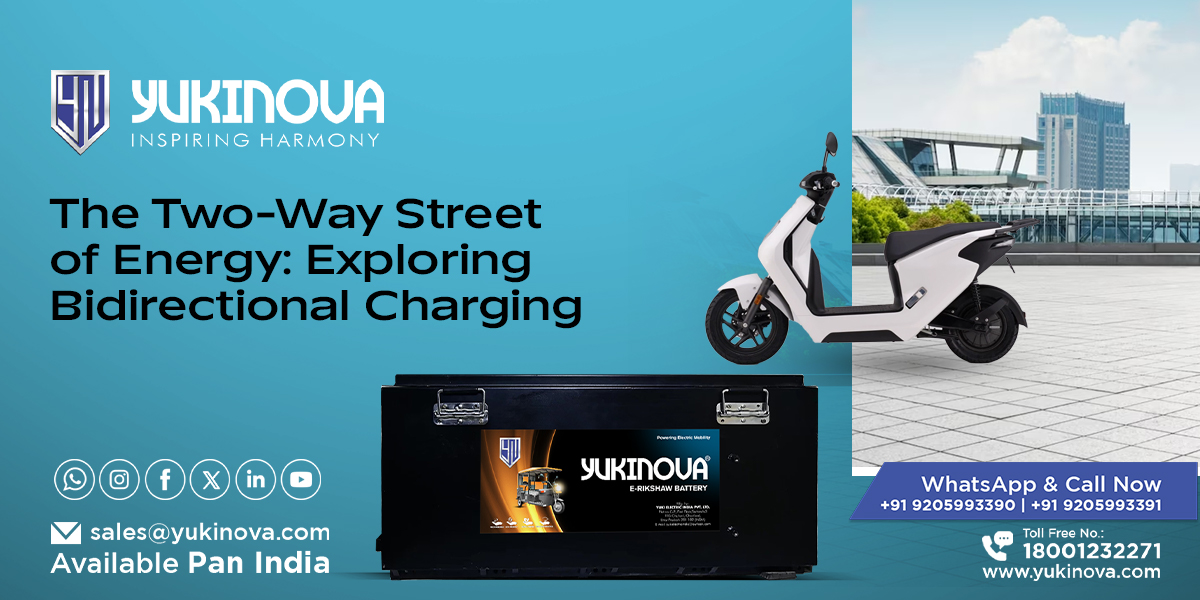In the realm of energy innovation, bidirectional charging technology stands out as a promising frontier, offering a two-way street for energy flow that could redefine how we power our vehicles. As a trusted and one of the leading scooty battery manufacturers based in Bangalore, Yukinova recognizes the transformative potential of bidirectional charging for two wheeler batteries and other electric vehicles. Let’s delve into this fascinating technology and explore its implications for the future of energy.
What is Bidirectional Charging Technology
Bidirectional charging technology, also known as vehicle-to-grid (V2G) technology, allows electric vehicles (EVs) to not only charge their batteries but also discharge energy back to the grid or other devices. This two-way energy flow enables EVs to serve as mobile energy storage units, contributing to grid stability and enabling energy sharing among vehicles and the grid. In recent times, Solar panels convert the sun’s energy and send it to the batteries, excess energy post charging can be diverted to power other appliances in the car.
Advantages of Bidirectional Charging
The advantages of bidirectional charging are multifaceted and impactful:
- Grid Stability: By allowing EVs to supply stored energy back to the grid during peak demand periods, bidirectional charging helps balance supply and demand, enhancing grid stability.
- Energy Resilience: In scenarios like power outages, bidirectional charging enables EVs to serve as backup power sources for homes or businesses, providing energy resilience and reducing reliance on traditional backup generators.
- Optimized Energy Use: Bidirectional charging facilitates optimal utilization of renewable energy sources by storing excess energy during periods of high generation and releasing it when needed, reducing waste and promoting sustainability.
- Cost Savings: EV owners can potentially earn revenue by participating in energy markets or providing grid services through bidirectional charging, offsetting the cost of EV ownership and incentivizing adoption.
- Environmental Benefits: By promoting the use of EVs and renewable energy integration, bidirectional charging contributes to reducing greenhouse gas emissions and mitigating climate change impacts.
Will it be really useful?
The utility of bidirectional charging extends beyond theoretical benefits, with practical applications already emerging in various sectors. For example:
1. Smart Energy Management: Bidirectional charging enables smart energy management systems that optimize energy use, storage, and distribution, leading to more efficient and resilient energy infrastructure.
2. Electric Vehicle Fleets: Bidirectional charging can revolutionize electric vehicle fleets, allowing for dynamic energy sharing, vehicle-to-vehicle charging, and enhanced operational flexibility.
3. Emergency Preparedness: In disaster-prone areas, bidirectional charging-equipped EVs can play a crucial role in disaster response and recovery, providing emergency power and support services.
Conclusion
Bidirectional charging technology represents a paradigm shift in how we perceive and utilize energy, offering a versatile and scalable solution for energy management, grid integration, and sustainable mobility. As Yukinova continues to innovate in the realm of two-wheeler batteries, bidirectional charging holds the promise of shaping a more resilient, efficient, and sustainable energy ecosystem. Embracing this technology heralds a future where vehicles not only consume energy but actively contribute to powering a cleaner, smarter world.
